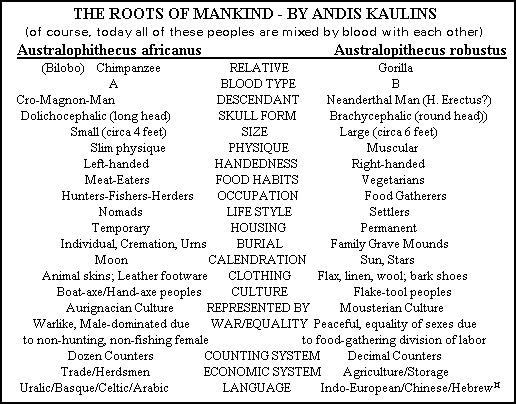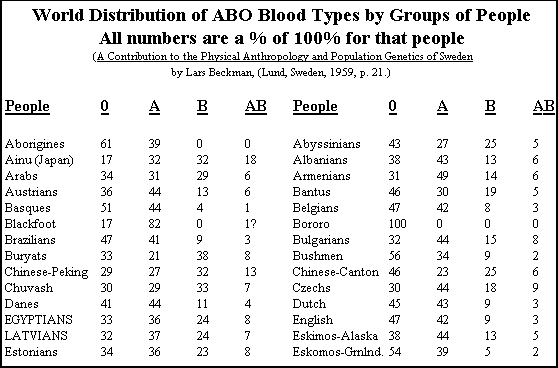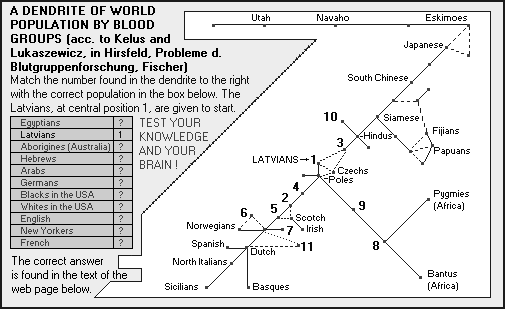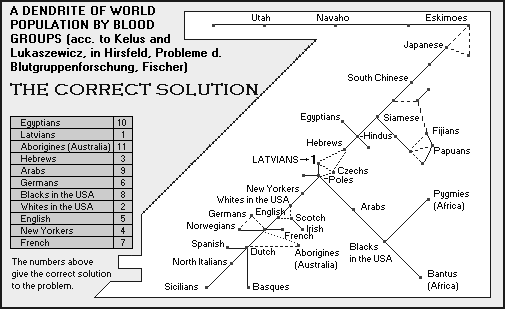|
|
|
from Expak Website recovered trough WayBackMachine Website
The Roots of Mankind
It is well known, for example, that the chromosomes of the man-apes (chimpanzees, gorillas, etc.) are very similar to those of man himself, differing in fact only very slightly, and thus suggesting a genetic relationship.
(As a source, you may want to read Dorothy A. Miller, Science magazine, Vol. 198, p. 1116.)
The study of (human) blood is called hematology.
Equally as interesting as chromosomes is an examination of blood types, the so-called ABO alleles and the MN alleles.
Most of us, for example, know our blood type in the ABO system, i.e.
(The positive or negative refer to the so-called Rhesus factor).
Persons with blood type O are so-called universal donors, since they can give blood to anyone having any of the blood types A, B, O or AB. Persons with blood type AB on the other hand, can give blood only to persons with AB blood type. A person with blood type A can not give blood to a person with blood type B and vice versa.
This means that a Kenyan with blood type
A can give blood to a Norwegian with blood type A, but a Norwegian
close relative with blood type B can not.
Given the above facts, blood types AB and O seem to be some form of combination of A+A, A+B or B+B (AB as exclusive and O as inclusive) - whereas A and B themselves appear to be separate original groups.
Only if the father and mother are A and B or B and A blood type can the child have any of the human blood groups A, B, AB or O.
This negates current theory that O is
the original blood type, especially since the man-apes have little
or no O blood type and no AB blood type. A and B are very likely the
originals.
But man has both A and B AND blood type AB as well as very much O.
The same holds true for the MN blood type, which is a different blood antigen. Man is both M and N or the combined MN blood type whereas the Chimpanzees and Gorillas react exclusively to these types. (According to Schmitt, the reactions of Chimpanzees are 00.16 to Anti-M human mucous and 10.00 to Anti-N, whereas the figures for Gorillas are exactly the reverse, with 10.00 to Anti-M and 00.64 to Anti-N).
Moreover, as noted by Philip Van Doren Stern, Prehistoric Europe (W.W. Norton & Co., N.Y., 1969, p. 28):
A + B = You and Me?
Accordingly, I suspect here that we might guess as to who Adam and Eve were, i.e. perhaps man developed on two separate lines from the man-apes or evolved from a combination of these two separate lines somewhere down the road.
Did you make the same connection?
Note: As noted by
Herberdt Wendt, (In Search of Adam, Houghton-Mifflin:
Boston, 1956) in spite of the historically unfounded and falsely bad
reputation of Neanderthal Man, his cranial capacity "was amazingly
large, 1300-1650 cc. in comparison with a range of 1100-1700 for
modern European males."
Handedness is another point of evidence for two separate groups of Man.
Suffice it here to say that Homo erectus, a precursor to man - never found in Europe - was right-handed, as were the Neanderthals. The ancient Cro-Magnon cave painters of Europe were almost certainly left-handed. (See Philip Van Doren Stern, Prehistoric Europe.)
Given this, our view of left-handers,
especially in continental Europe, is superstition.
In terms of the size of our predecessors, there is also evidence of two groups of human beings in ancient times.
As J. Bronowski wrote in his wonderful book, The Ascent of Man (Little, Brown & Co.: Boston, 1973, p. 38),
Herberdt Wendt in his book In Search of Adam (1956. notes 17, p. 362, p. 487) writes in this regard:
In terms of culture, Philip Van Doren Stern in Prehistoric Europe (1969) writes that,
Another researcher writes that the cultural record of the Pleistocene is said in fact to show "two cultural traditions", Jacquette Hawkes in Prehistoric Europe (Volume I of UNESCO's History of Mankind: London, 1963).
She states further,
All of these findings support the speculation of H.V. Vallois that there may indeed have been a "second line" of the evolution of humanity (cited by Wendt, In Search of Adam, p. 362, n. 17).
Wendt himself writes that,
Spectacular finds of giant-like human
skulls were found in Java, leading Franz Weidenreich to
publish a theory that a prehistoric race of giants once existed...
and that
these giants seemed to represent a transitional stage
from gorilla to man (Report of May 9, 1944 to the American
Ethnological Society: Apes, Giants and Man - Chicago: 1946).
The World Distribution of Human ABO
Blood Types by Peoples
The charts are based on the figures of L. Beckman 'A Contribution to the Physical Anthropology and Population Genetics of Sweden' Lund, Sweden, 1959
World Populations and Blood Groups
The results of
one branch of research must bear up to the burden of proof required
by the results derived from another branch of study.
One such group of facts which relates to the origins and dispersal of mankind and its languages throughout this planet - is blood data.
Theories about ancient cultures and discussion about the migrations of ancient peoples will increasingly have to conform to blood data provided by the physical sciences. We, who live in this world of DNA know that our TRUE history is etched indelibly in our genes - and in this technological age, we are increasingly in a position to read our past simply in our bodily chemistry. Or to put it in other words, we carry the answers to age-old questions about the origins of man WITHIN us.
The so-called "gene pool" is
reconstructable far back into the past.
Hence, theories about ancient cultures and languages which do not conform to these facts CAN NOT be true, and only those which DO conform to these facts CAN be true, although agreement does not guarantee that they ARE true.
Did you try your hand at getting the right solution? How do your numbers read from top to bottom? The odds against you getting them all right are astronomical - unless you are a specialist in the field of blood groups.
Linguistics, up to now, is still in its baby shoes, and many of the so-called "rules" which have developed will one day be put to test in computers - using the hypotheses derived - and I for one, doubt whether many of them will work - at least not in the historical sense.
New directions in e.g.
Nostratic support
this view.
The completed dendrite tells us clearly how man developed and how he scattered throughout the Earth, starting in Africa, moving northward and then branching to the East and West.
Indeed this conforms with topographical data since the Alps and the mountains of Asia presented insurmountable obstacles in ancient times. I.e. the direction of dispersal ran basically across the old Amber Trail, across the flatlands from the Black Sea to the Baltic and from thence in all directions.
This also conforms to the fact that the Baltic languages are the oldest Indo-European tongues - and, since BALT in Latvian means "white" (the old BALT inscriptions in Phoenician are incorrectly transcribed BA'AL), we see here the basic line between the whiter-skinned paled-out races of the north and their darker-skinned neighbors to the south.
Nothing could be more clear from this data, than that the Hebrews and Egyptians have a nearly common blood origin and that their geographic origin lies in the broad expanses of northern Euroasia, among a people linguistically close and related by blood to the Latvians and the neighboring peoples and dialects.
Or, as stated so often, the key might be
found in
the Kurgan connection, including
Sanskrit, Tocharian, etc.
|





